The medieval history of Serbia is an inspiring tale filled with great achievements, toil and struggle, and the strife of a small nation and its people as they attempt to rise to independence and prosperity. Even from the earliest moments of Serbia’s past, when the Slavic tribes became noticed in modern history, the Serbs held a crucial place in the developments pertaining to the Balkans and other corners of Europe, becoming entwined with the Byzantine Empire and its fate.
From early principalities and feuding nobles, to the emergence of the First Serbian Kingdom and long lasting dynasties, the Serbian medieval nation was on a steady rise towards greater heights. What’s more, this south Slavic nation did manage to reach those heights. The Serbian Empire arose in 1346 and became the leading political and economic power in the Balkans, held together by the ruler who created it – Tsar Dušan the Mighty.
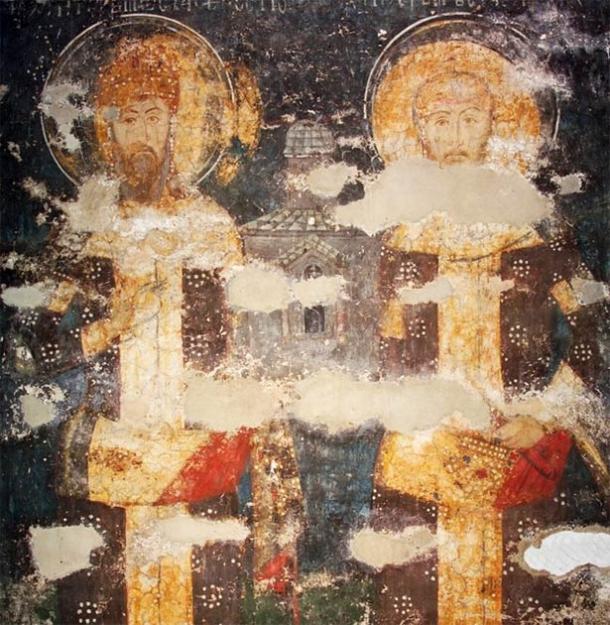
14th century fresco of father and son, Stefan Dečanski and Stefan Dušan, at Visoki Dečani monastery in Serbia. ( Public domain )
From Feud to Flourish: The Childhood of Dušan the Mighty
Dušan the Mighty was a skilled ruler and commander, even in his youth. Born as Stefan Uroš IV Dušan Nemanjić (Стефан Урош IV Душан Немањић), he would gain his epithet “the Mighty” only after his later achievements and the birth of the empire. Dušan was born in 1308, the son and heir of Stefan Uroš III Nemanjić, known as Stefan Dečanski (Стефан Дечански). Around the year 1314, the young Stefan Dečanski began a feud with his father, the king, and was sent to exile with his family all the way to Constantinople. His father ordered him to be blinded, as per the traditional custom, but it is likely that this did not occur, or that Stefan Dečanski was not completely blinded. Young Dušan was alongside his father during his exile.
Around 1318, Stefan Dečanski was allowed to return to Serbia, and his son Dušan remained at the court of his grandfather as a hostage. The latter died in 1321 and, after a year of conflict, Stefan Dečanski was crowned King, making his son the young king. Around 1331, relations between father and son became increasingly cold. One theory states that Stefan Dečanski intended to proclaim his younger son as heir, instead of Dušan.
There were also the increasing pressures of the ruling nobles and commanders, who urged young Dušan – 22 at the time – to rebel against his father. A popular pretense was the threat to Dušan’s role as heir, but the actual reason was the growing dissatisfaction of the prominent nobles. Stefan Dečanski had failed to act accordingly after winning the crucial Battle of Velbuzhd, meaning that he had not allowed his nobility to plunder Bulgaria and seize new territories. This was the main reason for their desire to rebel against him and place young Dušan on the throne.
This rebellion happened in 1331, turning father and son into enemies. In the first half of August of that year, the rebels under Dušan quickly travelled from one of the old Serbian capitals, Skadar (today in Albania), to the Nerodimlje complex in the southern Serbian region of Kosovo. Nerodimlje was the old and important court of the Serbian rulers, a cultural center and summer residence of sorts. As his son approached with an army, Stefan Dečanski fled to the nearby fort of Petrič (Петрич) which protected the residence. There he was soon surrounded and besieged, and eventually captured by his son.
Young Dušan crowned himself as the new King on September 8 th, 1331, in the fortress of Svrčin (Сврчин), while his father was imprisoned in the Zvečan Fortress. In its dungeons, Stefan Dečanski met his end. Some sources claim that his death was natural; others that he was strangled by order of his son. Some argue that the nobles had him strangled without the consent of the new King.

After the Battle of Velbazhd, ruling nobles began to plot against Stefan Dečanski, unhappy that he had not allowed them to plunder Bulgaria and seize new territories. This paved the way to placing the young Stefan Dušan on the throne. ( Public domain )
Exploiting the Byzantine Weaknesses: Early Conquests
The Byzantine Empire, that venerable descendant of the Eastern Roman Empire, entered into a troublesome and testing state of turmoil around the year 1341. This was the year that its Emperor, Andronikos III Palaiologos died, leaving as his heir a nine year old boy, John V Palaiologos. John VI Kantakouzenos, the late emperor’s chief advisor and friend, took up rule as a regent for the underage emperor, but his regency was soon disrupted by those wishing to support Empress Anna of Savoy. These two opposing sides created a noticeable rift at court, which was soon deepened when the followers of Kantakouzenos proclaimed him as co-emperor.
The feud soon turned into armed conflict, before erupting into full-blown civil war. This war would last from 1341 to 1347 and was a disastrous event for the Empire, reducing it to a mere rump state. Nevertheless, the role Serbia played in this conflict would greatly change the course of history.
John VI Kantakouzenos sought assistance from his friends, chiefly from King Dušan of Serbia. He had met the latter in July 1342, in the Serbian town of Priština (Приштина), where the two forged an alliance against the Empress Anna and her supporters. The deal stated that all parties would get to keep what they had conquered during war.
Dušan greatly exploited the civil war in order to make gains for his own nation. He began a systematic offensive towards the west in 1342, conquering without pity. Step by step Dušan and his armies conquered all Byzantine territories in the Western Balkans: the entire region of Albania was his by 1342 – 43, and the Byzantine forts of southern Macedonia fell soon after. In 1343 he conquered the territories east of River Vardar. By then it was clear to the Byzantines that their alliance with Dušan of Serbia had backfired. They broke all contact and Kantakouzenos sought an alliance with the Turks instead. But, by then it was too late. Dušan’s aggressive conquests had taken them by surprise.
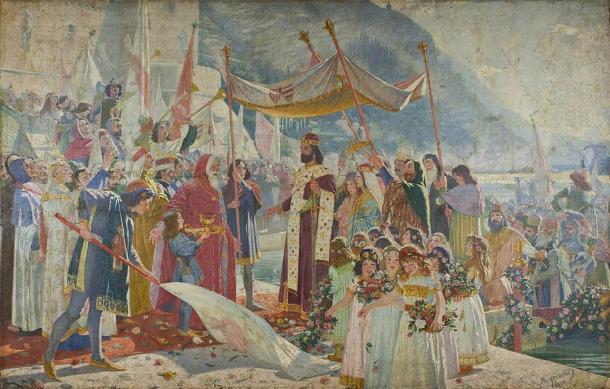
Dušan the Mighty proclaimed himself Tsar of the Serbian Empire. ( Public domain )
Birth of an Empire – Byzantines Ousted
Ultimately, Dušan – by then well deserving of his epithet “the Mighty” – conquered all pre-1341 Byzantine territories in the Western Balkans, stretching to Kaval in northern Greece, with an exception of Thessaloniki, which remained as an exclave surrounded by Serbs on all sides. Most scholars agree that Dušan the Mighty had the intention of conquering Constantinople itself and removing the Byzantine Empire, replacing it with a Serbo-Grecian Orthodox Christian Empire.
The conquered territories that would become the Serbian Empire stretched to Belgrade and Braničevo to the north, beyond the River Drina to the West, surrounding and bordering Ragusa (Dubrovnik) in the southwest, with the Adriatic Sea as its eastern border. To the West it encompassed the Bulgarian Empire acting as its vassal, and stretched all the way to Moldova and the mouth of the River Danube. To the south the Empire covered almost the entire Greek peninsula. In just a couple of years, Dušan the Mighty turned his Kingdom into the largest territory in the Balkans, creating a dominant force in every sphere and ousting the Byzantine Empire from its usual position of power.
Around 1343 Dušan began styling himself as “Dušan, King of Serbia, Albania, the Romans (Greeks), and the coast.” In 1345, he changed tack and began styling himself as tsar, the Slavic equivalent of emperor. On 25 th of September 1345, he at last conquered the city of Serres (Сер), an important Byzantine stronghold, and there proclaimed himself as the “ Tsar of Serbs and the Romans” (Romans here signifies Greeks to medieval Serbs, aka the Byzantines).
Following this, Dušan the Mighty sought a properly publicized proclamation. This happened in 1346, on 16 th of April: Easter day. The event took place in the capital city of the new Serbian Empire, Skopje (Скопље), the modern capital of North Macedonia. In a lavish ceremony attended by throngs of people, Dušan the Mighty was crowned Emperor. The ceremony was attended by all high officials and religious leaders. At the crowning, the then autocephalous Serbian Archbishopric was raised to the status of Serbian Patriarchate. Dušan became the Emperor and Autocrat of Serbs and Romans, and he granted his young son Uroš the title of King of Serbs and Greeks. The latter would focus on the administration of the heartland Serbian territories, while Dušan would focus on conquered Byzantine areas.
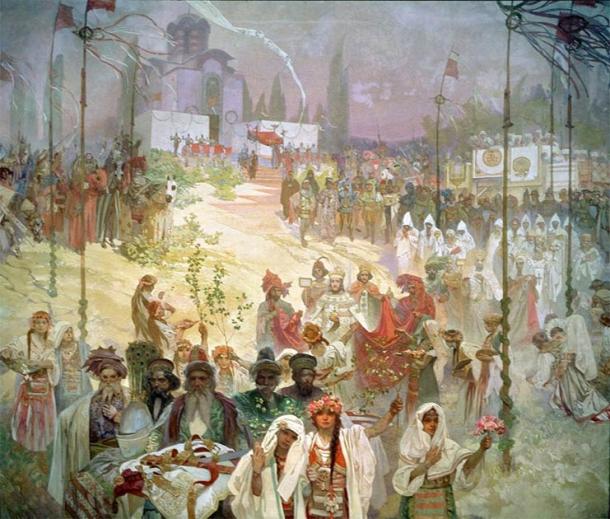
The coronation of Serbian Tsar, Štěpán Dušan. ( Public domain )
A Great Start: Instituting Dušan’s Code
After the creation of the Serbian Empire, the new Emperor Dušan at once adopted the court titles that were reserved only for the Byzantine imperial court. Thus his brother and brother-in-law became despotes (деспот) a title reserved for senior court members of the Byzantine court. His military commanders, until then known by the Slavic term voivodes (војводе), became caesars (кесар). Senior court officials became sebastocrator (севастократор), while court dignitaries would become domestikos (доместик, ставилац ). The chamberlain in charge of finance and taxation, by then known as казнац, became the protovestiarios (протовестијар).
Dušan the Mighty was known for his crucial reforms and capable leadership. He instituted important changes to the Serbian court and state which were celebrated for centuries to come. The most crucial achievement he enacted was the so-called Dušan’s Code (Душанов Законик), or Закон благовјернаго цара Стефана (Law of the Pious Emperor Stefan), a monumental law code that compiled several legal systems enacted by the new Emperor. It was a constitution and one of the most modern legal and stately works of its period. It continued to be used as a constitution even after Dušan, all the way until 1459, when the Ottoman’s annexed the later Serbian Despotate. The law code was extensively copied in monasteries, and several of these transcripts survive today, the earliest from the 14 th century.
The law code was established on May 21 st 1349 at the capital Skopje, and further enriched in 1354, at Serres. This law was envisioned as a way to regulate the Serbian state and all aspects of life within it, for all citizens alike. The entire law code consisted of 201 articles, and touched upon every important sphere of life in the Empire. The laws covered aspects related to church and religion, civil law, disputes and criminal law, and so on. The laws of Dušan’s rule were known to be just and balanced, but rigorous nonetheless. Those who broke the law would suffer harsh punishments. It remains one of the most important works of Medieval Serbian history.
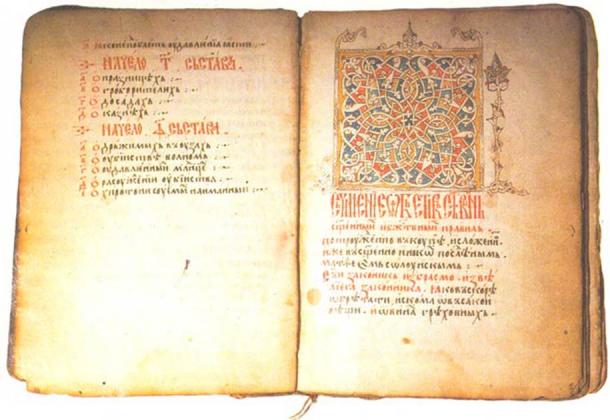
One of Dušan the Mighty’s main achievements was the installation of Dušan’s Code a monumental law code that compiled several legal systems enacted by the new Emperor. ( Public domain )
An Emperor’s Burial in Ruins
Emperor Dušan the Mighty died on Sunday, December 20 th, 1355. It is said that he died while en route to new conquests against the Byzantine forces. The cause of his death remains unknown, and many different theories exist. Dušan was buried in his own endowment, the Monastery of Holy Archangels in Prizren (Призрен), the city which was also his capital for a time. Prizren was a crucial Serbian medieval city and a hub for trade, culture, and art.
Dušan chose the vicinity of this town for his endowment. He constructed a large (6,500 square meters) monastery complex surrounded by a fortress complex, in a remote canyon of the Prizrenska Bistrica river. There he was eventually laid to rest in a monumental royal marble tomb. A century after the emperor’s death, the Ottomans sacked the monastery in 1455, only to completely raze it to the ground in 1615. After destroying it, the Ottoman Turks used the stones to create the Sinan-Pasha Mosque in Prizren.
The ruins of the complex were excavated in 1927, when the remnants of a tomb were discovered, which turned out to be Dušan’s. The valuables with which he was buried were sacked long ago, but his bones remained. Today they lie in Belgrade, but once the monastery has been rebuilt they will return to their home in Prizren. In 1998, the ruins became an active monastery once more and housed several monks. Alas, Alabanians sacked and burnt it down in 1999. Today it is once more an active monastery, with eight Serbian monks living in the ruins. They are protected by forces of KFOR.
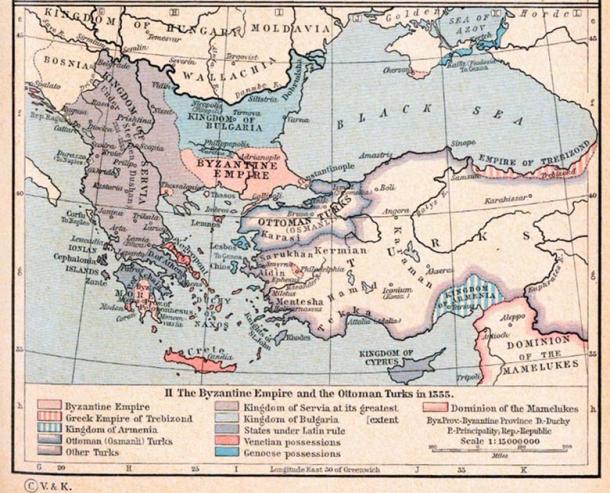
Map showing the Serbian Empire at the height of its power in 1355. ( Public domain )
Dušan’s Empire Crumbling
Dušan the Mighty was inherited by his son, Stefan Uroš V, also known as Uroš the Weak (Урош Нејаки). Uroš gained this epithet for not being able to preserve the Empire of his father. With constant pressures from the outside, alongside the internal divisions and feuds of the Serbian nobles, Dušan’s vast empire soon began to crumble. The once centralized ruling force of Dušan’s empire became weak and the nobles grew increasingly independent.
Uroš had no issue, and is thus the last ruler of the famed Nemanjić Dynasty (Немањићи).
What Dušan managed to achieve with his capable rule was not destined to last long. The fragmented Serbian state was not capable of withstanding the new threat that was coming from the east. After the devastating Battle of Kosovo in 1389 (Косовска Битка), the gradual conquest of Serbia and the Balkans began. Even so, Dušan the Mighty remains as one of Serbia’s most important and venerated historical figures and fathers, and his deeds mark the heights of the power of Medieval Serbia.
Top image: Dušan the Mighty, seen here in a detail of a 14 th century fresco at Lesnovo Monastery in the Republic of Macedonia, ousted the Byzantine Empire from power in the region to create the great Serbian Empire which rose in the 1340s to become the leading political and economic power in the Balkans. Source: Public domain .
References
Cox, J. 2002. The History of Serbia. Greenwood Publishing Group.
Fine, J. 1994. The Late Medieval Balkans: A Critical Survey from the Late Twelfth Century to the Ottoman Conquest . University of Michigan Press.
Various, 1998. Studies on the Internal Diaspora of the Byzantine Empire. Dumbarton Oaks.
Алексић, М. 2015. Реформа Српске Војске у Време Стефана Душана. Војно-Историјски Гласник.
Ћоровић, В. 2001. Историја Српског Народа – Стварање Српског Царства/Дело Цара Душана. Јанус.
 RSS Feed
RSS Feed















 August 19th, 2020
August 19th, 2020  Awake Goy
Awake Goy  Posted in
Posted in  Tags:
Tags: 













